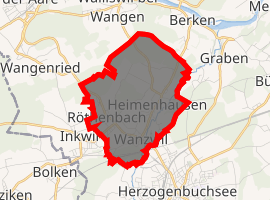Heimenhausen
Heimenhausen is a municipality in the Oberaargau administrative district in the canton of Bern in Switzerland.
Heimenhausen | |
|---|---|
 Coat of arms | |
Location of Heimenhausen 
| |
 Heimenhausen  Heimenhausen | |
| Coordinates: 47°13′N 7°42′E | |
| Country | Switzerland |
| Canton | Bern |
| District | Oberaargau |
| Government | |
| • Mayor | Verena Schertenleib-Helbling |
| Area | |
| • Total | 5.9 km2 (2.3 sq mi) |
| Elevation | 455 m (1,493 ft) |
| Population (2018-12-31)[2] | |
| • Total | 1,142 |
| • Density | 190/km2 (500/sq mi) |
| Postal code | 3373 |
| SFOS number | 0977 |
| Surrounded by | Berken, Graben, Herzogenbuchsee, Röthenbach bei Herzogenbuchsee, Walliswil bei Wangen, Wanzwil |
| Website | www SFSO statistics |
On January 1, 2009, the municipalities of Wanzwil and Röthenbach bei Herzogenbuchsee became part of the Municipality of Heimenhausen.[3]
History
Heimenhausen is first mentioned in 1356 as Heimenhusen.[4]
Geography
Heimenhausen has an area, as of 2009, of 5.85 km2 (2.26 sq mi). Of this area, 3.08 km2 (1.19 sq mi) or 52.6% is used for agricultural purposes, while 2.03 km2 (0.78 sq mi) or 34.7% is forested. Of the rest of the land, 0.68 km2 (0.26 sq mi) or 11.6% is settled (buildings or roads), 0.02 km2 (4.9 acres) or 0.3% is either rivers or lakes and 0.02 km2 (4.9 acres) or 0.3% is unproductive land.[5]
Of the built up area, housing and buildings made up 6.8% and transportation infrastructure made up 3.2%. Power and water infrastructure as well as other special developed areas made up 1.2% of the area 33.8% of the total land area is heavily forested. Of the agricultural land, 36.1% is used for growing crops and 15.7% is pastures. All the water in the municipality is in rivers and streams.[5]
Demographics
Heimenhausen (alone) has a population (as of 31 December 2018) of 1,143.[6] As of 2007, 3.1% of the population was made up of foreign nationals. Over the last 10 years the population has decreased at a rate of -9.3%. Most of the population (as of 2000) speaks German (98.5%), with Serbo-Croatian being second most common ( 0.7%) and French being third ( 0.2%).
In the 2007 election the most popular party was the SVP which received 50% of the vote. The next three most popular parties were the FDP (14.5%), the SPS (12.1%) and the local small left-wing parties (8.8%).
The age distribution of the population (as of 2000) is children and teenagers (0–19 years old) make up 29.6% of the population, while adults (20–64 years old) make up 55.2% and seniors (over 64 years old) make up 15.2%. About 82% of the population (between age 25-64) have completed either non-mandatory upper secondary education or additional higher education (either university or a Fachhochschule).
Heimenhausen has an unemployment rate of 1.52%. As of 2005, there were 34 people employed in the primary economic sector and about 11 businesses involved in this sector. 2 people are employed in the secondary sector and there are 2 businesses in this sector. 31 people are employed in the tertiary sector, with 6 businesses in this sector.[7] The historical population is given in the following table:[4]
| year | population |
|---|---|
| 1764 | 192 |
| 1850 | 388 |
| 1900 | 416 |
| 1950 | 343 |
| 1980 | 287 |
| 2000 | 453 |
References
- "Arealstatistik Standard - Gemeinden nach 4 Hauptbereichen". Federal Statistical Office. Retrieved 13 January 2019.
- "Ständige Wohnbevölkerung nach Staatsangehörigkeitskategorie Geschlecht und Gemeinde; Provisorische Jahresergebnisse; 2018". Federal Statistical Office. 9 April 2019. Retrieved 11 April 2019.
- BSG 152.01 BAG 08-59 Archived 2011-07-17 at the Wayback Machine Die Justizkommission des Grossen Rats des Kantons Bern (Justice Commission of the High Council of Canton Bern) decision of 29 April 2008. (in German) accessed 16 July 2009
- Heimenhausen in German, French and Italian in the online Historical Dictionary of Switzerland.
- Swiss Federal Statistical Office-Land Use Statistics 2009 data (in German) accessed 25 March 2010
- Swiss Federal Statistical Office - STAT-TAB, online database – Ständige und nichtständige Wohnbevölkerung nach institutionellen Gliederungen, Geburtsort und Staatsangehörigkeit (in German) accessed 23 September 2019
- Swiss Federal Statistical Office Archived 2016-01-05 at the Wayback Machine accessed 20-Jul-2009
External links
| Wikimedia Commons has media related to Heimenhausen. |
- Heimenhausen in German, French and Italian in the online Historical Dictionary of Switzerland.